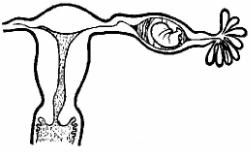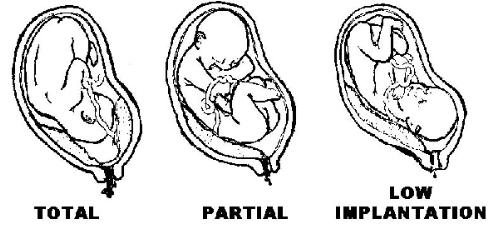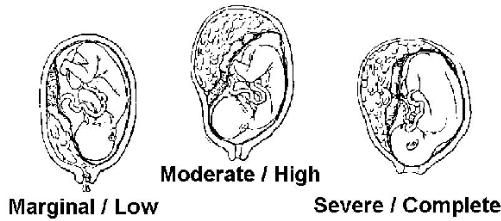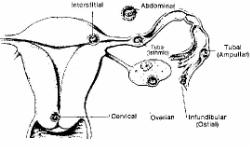This is the Archived Desktop Edition.
You should be transferred to the Newest Edition for Desktop and Mobile within 2 seconds.
Lesson 1: Complications of Pregnancy
a. Ectopic pregnancy (figures 1-3 and 1-4) is any pregnancy that does not occupy the uterine cavity properly. The causes of ectopic pregnancy are abnormally narrowed fallopian tubes, infection (scar tissue on the fallopian tubes), or tumor formation. Hemorrhage is extremely serious. The classic symptom is a severe knife-like pain in the lower abdominant quadrant.
b. Nursing implications are listed below.
(1) Provide comfort measures to the mother.
(2) Offer emotional support to anxious/frightened the mother.
(3) Offer emotional support to the mother as she is depressed from loss of her child.
(4) Assess the spiritual needs of mother and child.
|
|
 Figure 1-4. Tubal pregnancy. |
a. Placenta previa is hemorrhage resulting from the low implantation of the placenta on the interior uterine wall. It is common in multiparous mothers. The cause is unknown.
b. There are three types of placenta previa. Each type is identified according to the degree to which condition is present (see figure 1-5).
(1) Total placenta previa. This occurs when the placenta completely covers the internal os.
(2) Partial placenta previa. This occurs when the placenta partially covers the internal os.
(3) Low implantation of placenta previa. This occurs when the placenta is attached at the opening or border to the cervical os, but not covering it.

Figure 1-5. Types of placenta previa.
c. Nursing implications are listed below.
(1) Teach the patient to report any painless vaginal bleeding.
(2) Monitor vital signs. Hypovolemic shock may be present.
(3) Monitor fetal heart tones per orders.
a. Abruptio placentae is hemorrhage resulting from the detachment of the placenta. Hypertension may cause this. It may occur any time during pregnancy. If the placenta becomes detached prior to the 20th week of gestation it is called a spontaneous abortion.
b. Abruptio placentae may be classified in three types of separation (see 0figure 1-6).
(1) Marginal/low separation. This occurs when the separation is low and is not complete; vaginal hemorrhage is evident.
(2) Moderate/high separation. This occurs when the separation is high in the uterine segment, causing the fundus of the uterus to rise. The fetus is in grave danger because of lack of oxygen. External hemorrhage will probably not be present here, whereas the amniotic fluid will be a port-wine color.
(3) Severe/complete separation. This occurs when the fetus head is present in the cervical os that prevents external hemorrhage. The fetus is in grave danger, and an immediate cesarean section will probably be needed in order to save the baby's and mother's lives.

Figure 1-6. Types of abruptio placentae.
c. Nursing implications are listed below.
(1) Record amount and character of vaginal bleeding.
(2) Maintain thorough peri-care to keep the mother feeling clean.
(3) Monitor the fetal heart tones per order. Deceleration indicates diminishing placental function.
(4) Monitor the mother's vital signs per OB practitioner's or physician's orders. Death occurs from hypovolemic shock.
(5) Monitor IV fluids per order. IV fluids will be administered to replace fluid volume.
a. Abortion refers to the loss of the fetus before viability (twenty weeks gestation or fetal weight of 400 gr/14 oz) (see figure 1-7). The types of abortion are:
(1) Spontaneous (miscarriage)-the process starts of its own accord through natural causes.
(2) Induced-intervention by outside source whether therapeutic or other reasons.
(3) Threatened-possible, but can be prevented. Bleeding or spotting occurs with the cervix closed. The patient may have mild cramps.
(4) Inevitable-the process has gone so far that loss of the fetus will occur, it cannot be prevented.
(5) Incomplete-parts of the products of conception have been passed, but part (usually the placenta) is retained in the uterus.
(6) Complete-all products (placenta and fetus) of pregnancy are eliminated.
NOTE: See figure 1-7 for some types of abortion.

Figure 1-7. Some types of abortion.
b. Nursing implications are listed below.
(1) Implement all nursing measures for a patient on complete bed rest.
(2) Monitor peri-pads for amount and character of vaginal bleeding.
(3) Be knowledgeable of local laws which support legal abortions.
(4) Refer questions of legal abortions to immediate supervisor so further counseling can be offered to the mother.
(5) Assess the mother's emotional and spiritual needs.
1-16. PROLAPSED UMBILICAL CORD
a. A prolapsed umbilical cord occurs when the umbilical cord precedes the presenting part of the fetus so that the blood circulating inside the cord is clamped off by the passing fetus through the birth canal. This is considered an obstetric emergency.
b. Nursing implications are listed below.
(1) Monitor the fetal heart tones per orders.
(2) Examine the patient's vaginal canal to determine the presence of a cord.
(3) Notify your supervisor immediately.
1-17. PREMATURE LABOR AND BIRTH
a. Premature labor and birth refers to a baby born "before its time," that is, before the end of the 37th gestational week. Premature babies are likely to suffer respiratory distress. Medications may be administered to suppress the patient's labor. The medications are Brethina®, terbutaline, nifedipine, indomethacin, and magnesium sulfate.
b. Nursing implications are listed below.
(1) Monitor the patient who is receiving medications for hypotension and tachycardia. Report vital signs to your immediate supervisor.
(2) Be alert to the patient's psychological and spiritual needs. She may be frightened and anxious. Her labor will be very demanding since her baby is not fully prepared.
|
|||||||||
|
LESSON OBJECTIVES After completing this lesson, you should be able to: 1-1. Identify facts concerning complications and nursing implications of a pregnant woman, including are: |
|||||||||
|
The Brookside Associates Medical Education Division is dedicated to the development and dissemination of medical information that may be useful to medical professionals and those in training to become medical professionals. This website is privately-held and not connected to any governmental agency. The views expressed here are those of the authors, and unless otherwise noted, do not necessarily reflect the views of the Brookside Associates, Ltd., any governmental or private organizations. All writings, discussions, and publications on this website are unclassified.
© 2007 Medical Education Division, Brookside Associates, Ltd. All rights reserved
